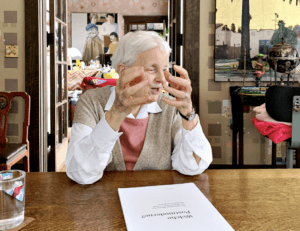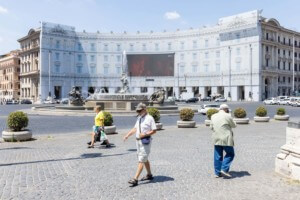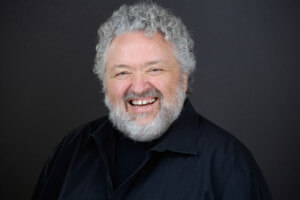The main exhibit hall at the Pennsylvania Convention Center in Philadelphia is as long as three city blocks. This is a universal space, unencumbered by columns, and enriched by connection points and affordances that offer access to electricity, light, water, ventilation. This space could hold and sustain almost anything. Today, as part of the AIA National Convention, it is filled with the elements of building, decontextualized and layered on top of one another in delirious profusion of texture and meaning. Here, a mockup of an elevator booth, across the aisle, a maze constructed entirely of doors. Signs over the booths invite us to do things like “Re-Think Wood,” and “Build our Community.” They remind us that “Glass is Everything.” A company making door knobs and handles announces that it is “The Global Leader in Door Opening Solutions.”
The breathless valorization of the normal is infectious. Things and people here seem on the verge of tipping over into some kind of technological singularity of the everyday. Even ordinary conversations occur with an extra layer of mediation. Each interaction with the staff at a booth is punctuated with an unusual question, “do you mind if I scan your badge?” Attendees are all wearing custom lanyards with QR codes, which booth staff photograph using smartphone apps, quantifying and upgrading any simple question about building components into an elevated transactional informational layer. This halo around the space, people, and things is also visible on the official convention app, where continuous backchannel discussions and jokes flow in real time, pulling attendees from the gridded space of the convention hall back into its virtual counterpart.
Two architects are haunting this universal space: Denise Scott Brown and Rem Koolhaas. The exhibit hall’s collection of elements can’t help but bring to mind the Venice Biennale exhibition that Koolhaas curated in 2014. His Elements of Architecture show included a suspended acoustic tile ceiling installed under an ornate frescoed dome, and a collection toilets from throughout history, with detailed annotations.
Similarly, the signs at the convention’s exhibits recall the gallery work and research of Scott Brown and her husband/partner Robert Venturi. For the 1976 show Signs of Life: Symbols in the American City, at the Smithsonian, the pair gave voices to the ordinary pieces of the domestic landscape. “Historical Elegance” says the ironwork on a rowhouse front door, “Regency Style” announces a suburban living room armchair. In her 1972 book, Learning From Las Vegas, Scott Brown, Venturi, and a third collaborator, Steven Izenour, drew a warehouse shed building with a large billboard optimistically declaring “I am a Monument.”
And there the drawing is, on a t-shirt available in the gift shop off the main hall. And here is Scott Brown herself, onstage with AIA President Russell Davidson and Executive Director Robert Ivy. They are awarding the AIA Gold Medal to her and Venturi. This is the first time that this award has gone to collaborative partnership, they announce, and they have voted to change the medal’s rules, just to make this possible. This is extraordinary, and long overdue, but it is also extraordinarily normal. Architects have been working together in partnerships for centuries. To adapt Scott Brown’s own language, this moment, that has the audience of thousands on their feet and overcome with emotion, is Heroic and Original, but it’s also Ordinary, and the failure, up until now, of the AIA to recognize and valorize this normal everyday mode is certainly a bit Ugly.
Architecture, like Main Street, is almost alright. After Scott Brown, we hear from Koolhaas, onstage with Mohsen Mostavi, the Dean of Harvard’s GSD. Reminiscing about Learning From Las Vegas, Koolhaas said “I remember very clearly when I first saw a copy of that book. It was extraordinary, I bought it right away.” Koolhaas has just finished signing hundreds of copies of his own 1978 book Delirious New York, A Retroactive Manifesto for Manhattan for sale in the bookstore alongside the “I am a Monument” shirts.
That book had chronicled the assimilation of the disruptive effect that several new technologies had on architecture in Manhattan: the steel frame, the elevator, the electric light, and the air conditioner. This re-normalization had taken place in the universal space of the 1811 street grid, allowing for the accommodation of difference in a way not unlike the neutral space of the convention center’s exhibit hall holds the diverse booths. Although the two interlocutors never mention the city we are all in, the title of Mostavi and Koolhaas’ talk is “Delirious Philadelphia.” Billed by Ivy as “a real kick in the pants,” the talk turns out to be quite an ordinary, low key conversation.
Koolhaas’ own grand experiment with the nonstandard, Beijing’s CCTV Building, for China’s state controlled media, was another topic touched on by Mostavi and Koolhaas. It was completed in 2012, and in 2014, Chinese President Xi Jinping used it as an example to call for the end of what he called “weird architecture” in China. An official directive in 2016 followed up on this allusion, saying that buildings which are “oversized, xenocentric, weird,” will no longer be permitted. “I share the opinion of my own most powerful critic,” Koolhaas says, onstage in Philadelphia, “I am also perhaps skeptical of weird architecture.”
Architecture is entering a period in which the destabilizing effects of robotics, digital communication, and computation are being brought to ground. New internet protocols coming online in the next few years will automate many aspects of the home, and there will soon be enough new IP addresses available to give every armchair and billboard its own identity and ability to communicate, fulfilling Scott Brown’s vision of assertive home furnishings and self aware monumentally generic buildings. We will all have our badges to scan, and our conversations with each other, our spaces, and our things will be captured and recuperated constantly. As in Koolhaas’s Manhattan, and in the conventionally universal convention space in Philadelphia, weirdness and xenocentrism will be deprecated and absorbed. In the future, everything will be normal.










